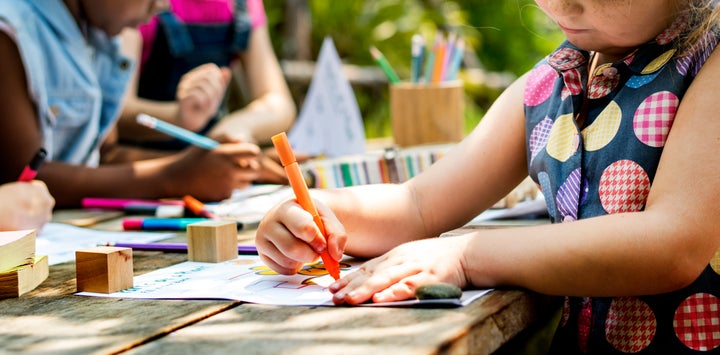
Storytelling is great for stretching a child’s imagination. Research has found that it is key to children’s development. In a study of around 15,000 children between the ages of three and five, it was seen that story sessions influenced both socio-emotional development and cognitive skills.
Art is such an effective mechanism for storytelling. It’s primarily visual focus means that even those children who are not confident about writing or find it difficult to express themselves in words can use the images as an anchor. Unlike written text that requires a leap of imagination from the words and pictures on a page, the artwork allows the child to sprint ahead into multi-colour visualisation.
There are two main ways that storytelling can be encouraged using Art as a medium: using artworks to wave narratives and using art to express emotions.
In the first case, children can be taught to read artworks. Children have a natural ability to interpret visual cues and gestures, as that is where their first understanding of the world comes from. Research has shown that when and how babies speak depends to a large understanding to what they see around them. Visual experience is the key in learning words. So, providing children with art to look at and helping them weave stories around them builds and strengthens their vocabulary.
In the second case, art can be a very effective mechanism to visually represent a story that children create in their imaginations. Sometimes young children do not have the necessary sophisticated vocabulary to express everything that they are imagining, and lack of appropriate language can inhibit their expression and in some cases their self-confidence. Visual representations through stories can also be very effective for dyslexic children and those with other learning difficulties.
Here are some strategies to encourage storytelling through art with children:
1. Start with a painting
Start with selecting a painting that might already have a myth or a story attached to it, or an artist who has an interesting story. It could also be that the painting is set in a time or place that has a particularly significant context or historical event associated with it. Depending on the age of the child, select a painting with appropriate numbers of characters or complexity of visual elements. Sometimes it helps to find an artwork that is related to a place that the child is familiar with or a place that is meaningful for the child as a starting point.
2. Observe
Encourage children to really observe the painting. This is not just about saying whether they like it or not, but to start looking at specific details. Things such as: colours, shapes, characters and interaction between them, foreground and background, unusual textures. Avoid judgement and let the child take the lead and what they really see. Keep the questions open-ended.
3. Step into the picture
After seeing “what”, the children can be guided through a discussion of “when” and “why”. This encourages critical and creative thinking, and unleash the imagination. Ask the children to metaphorically step into the picture, and inhabit the world in the painting. They can start developing a story around their own character in the artwork.
4. Walk in the artist’s footsteps
Encourage the child to develop a story beyond what is visible in the image. One way to do this could be to prompt them to consider the story of the artist. For instance, what was Monet doing when he painted his waterlilies? Where was he sitting? What did he do just before? What did he have for breakfast? Was he alone? Where was he sitting?
Of course, some of this would be documented and that could form a point of discussion later on, but in the first instance letting the child create a narrative around the artist and their motives for a particular artwork allows them to not only stretch their imagination but also interpret the artwork in an entirely new way. This also nurtures the storytelling skills in children by observing and analysing visual cues, but creating a world that crosses the imaginary and the real.
The role of pictures and drawing in developing children’s communication skills has been proven. By encouraging them to create and tell stories through art and also use stories as a basis for new artwork has huge developmental and cognitive benefits. It will also nurture a life-long love of art, while introducing very important skills of observing closely, interpreting and analysing visual media and culture. While doing so, it is really important to give children the time to observe, reflect and question their own preconceptions, values and judgements.